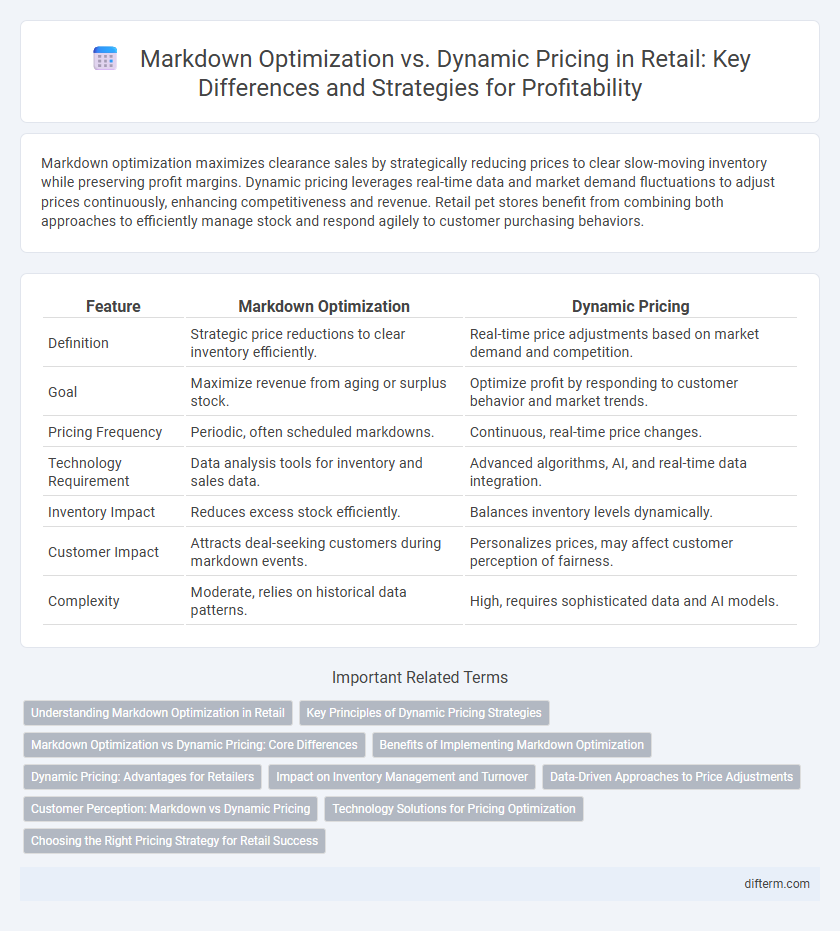Markdown optimization maximizes clearance sales by strategically reducing prices to clear slow-moving inventory while preserving profit margins. Dynamic pricing leverages real-time data and market demand fluctuations to adjust prices continuously, enhancing competitiveness and revenue. Retail pet stores benefit from combining both approaches to efficiently manage stock and respond agilely to customer purchasing behaviors.
Table of Comparison
| Feature | Markdown Optimization | Dynamic Pricing |
|---|---|---|
| Definition | Strategic price reductions to clear inventory efficiently. | Real-time price adjustments based on market demand and competition. |
| Goal | Maximize revenue from aging or surplus stock. | Optimize profit by responding to customer behavior and market trends. |
| Pricing Frequency | Periodic, often scheduled markdowns. | Continuous, real-time price changes. |
| Technology Requirement | Data analysis tools for inventory and sales data. | Advanced algorithms, AI, and real-time data integration. |
| Inventory Impact | Reduces excess stock efficiently. | Balances inventory levels dynamically. |
| Customer Impact | Attracts deal-seeking customers during markdown events. | Personalizes prices, may affect customer perception of fairness. |
| Complexity | Moderate, relies on historical data patterns. | High, requires sophisticated data and AI models. |
Understanding Markdown Optimization in Retail
Markdown optimization in retail involves strategically adjusting prices on products to clear excess inventory while maximizing revenue and minimizing profit loss. It relies on data analytics, historical sales trends, and inventory levels to determine the most effective timing and depth of discounts. This method prioritizes balancing inventory turnover with profitability, contrasting with dynamic pricing's real-time price fluctuations based on market demand and competitor pricing.
Key Principles of Dynamic Pricing Strategies
Dynamic pricing strategies leverage real-time data analysis, customer behavior insights, and competitive market trends to adjust prices dynamically, maximizing revenue and market share. Key principles include demand-based pricing, inventory sensitivity, and price elasticity to respond instantly to fluctuating market conditions. Integration of advanced algorithms and machine learning enables retailers to optimize pricing decisions, enhancing profitability while maintaining customer satisfaction.
Markdown Optimization vs Dynamic Pricing: Core Differences
Markdown optimization focuses on strategically reducing prices on selected inventory to clear stock and maximize revenue, relying heavily on historical sales data and inventory levels. Dynamic pricing continuously adjusts product prices in real-time based on market demand, competitor pricing, and customer behavior to optimize profitability and sales velocity. The core difference lies in markdown optimization's fixed, pre-planned discounting approach versus dynamic pricing's flexible, algorithm-driven price adjustments.
Benefits of Implementing Markdown Optimization
Markdown optimization enhances inventory turnover by strategically timing price reductions based on demand forecasts and sales velocity. It maximizes profit margins by identifying the optimal discount level that balances volume increases without eroding brand value. Compared to dynamic pricing, markdown optimization provides greater predictability and simplicity in pricing strategies, reducing customer confusion and maintaining consistent market positioning.
Dynamic Pricing: Advantages for Retailers
Dynamic pricing enables retailers to adjust prices in real-time based on market demand, competitor strategies, and inventory levels, maximizing revenue and minimizing stockouts. This approach improves profitability by capturing consumer willingness to pay more accurately than static markdown optimization methods. Retailers also gain increased flexibility to respond swiftly to changing market conditions, enhancing overall sales performance and customer satisfaction.
Impact on Inventory Management and Turnover
Markdown optimization streamlines inventory management by strategically reducing prices to clear slow-moving stock, directly improving turnover rates through targeted discounting. Dynamic pricing leverages real-time data and algorithms to adjust prices based on demand fluctuations, maximizing revenue while balancing inventory levels efficiently. Both approaches enhance turnover, but dynamic pricing offers more granular control over inventory velocity and margin preservation in retail environments.
Data-Driven Approaches to Price Adjustments
Markdown optimization leverages historical sales data and inventory levels to strategically reduce prices on slow-moving products, enhancing clearance efficiency and maximizing revenue recovery. Dynamic pricing employs real-time market demand, competitor prices, and customer behavior analytics to continuously adjust prices, driving optimal profit margins and competitive positioning. Both approaches rely on advanced data-driven algorithms to fine-tune pricing strategies, improving inventory turnover and overall retail profitability.
Customer Perception: Markdown vs Dynamic Pricing
Markdown optimization enhances customer perception by offering clear, predictable discounts that build trust and urgency. Dynamic pricing can create confusion or distrust due to fluctuating prices, potentially diminishing perceived fairness. Retailers must balance transparency and value, as markdowns foster loyalty while dynamic pricing captures optimal revenue.
Technology Solutions for Pricing Optimization
Technology solutions for pricing optimization in retail leverage advanced algorithms and machine learning to enhance markdown optimization and dynamic pricing strategies. Markdown optimization tools analyze historical sales data and inventory levels to determine the best timing and depth of discounts, maximizing revenue and minimizing excess stock. Dynamic pricing platforms utilize real-time demand signals, competitor prices, and customer behavior to adjust prices continuously, improving margin management and market responsiveness.
Choosing the Right Pricing Strategy for Retail Success
Markdown optimization focuses on maximizing margins by strategically reducing prices to clear inventory, while dynamic pricing adjusts prices in real-time based on demand, competition, and market trends. Retailers must evaluate factors like product lifecycle, customer behavior, and inventory levels to select a strategy that balances profitability and sales velocity. Leveraging data analytics and AI-driven tools enhances decision-making, ensuring pricing aligns with business objectives and market conditions for optimal retail success.
Markdown Optimization vs Dynamic Pricing Infographic

 difterm.com
difterm.com